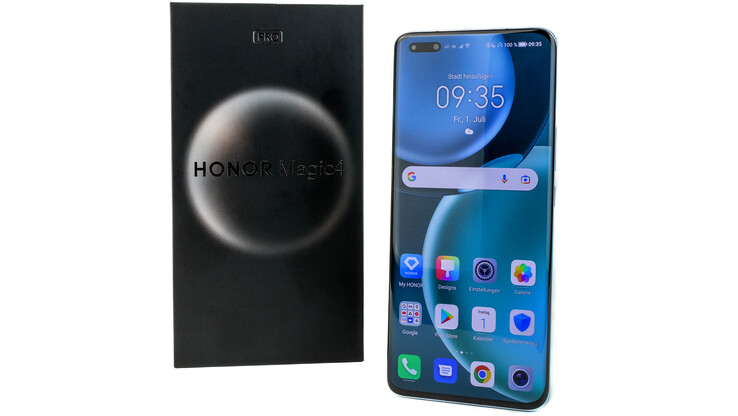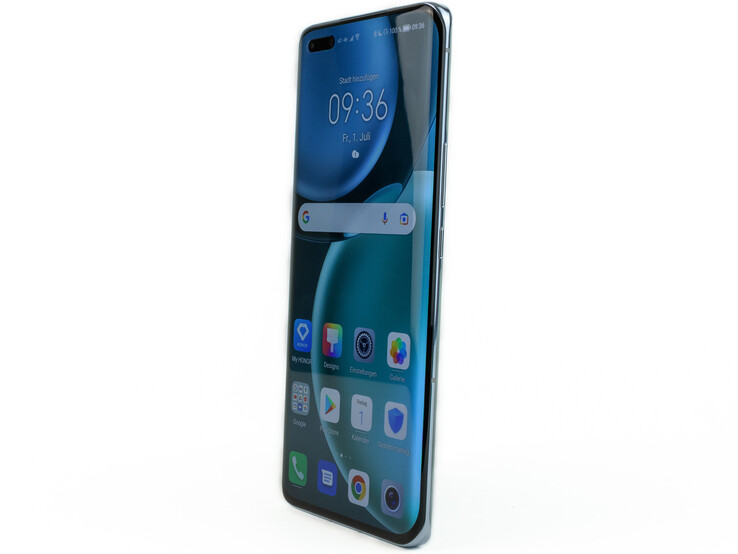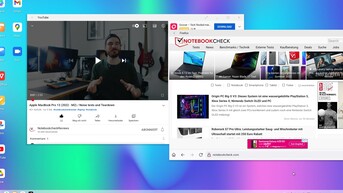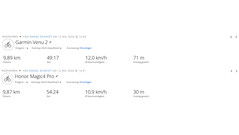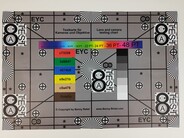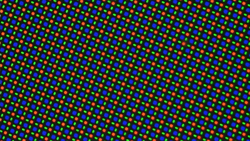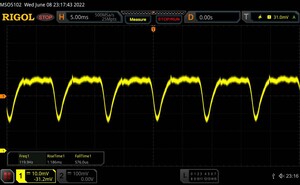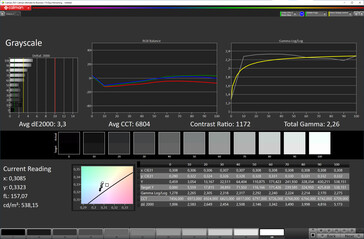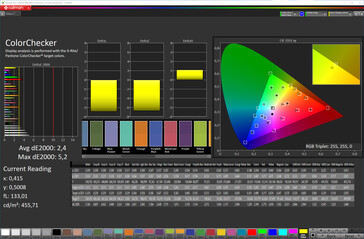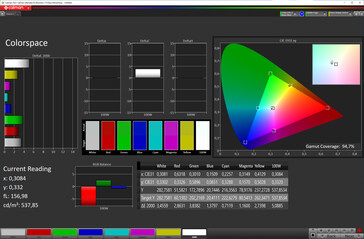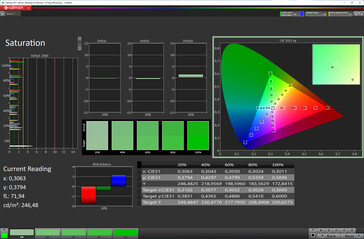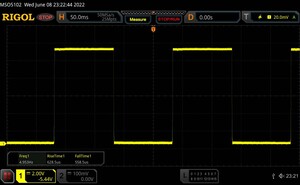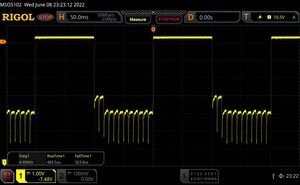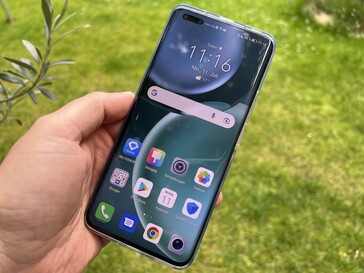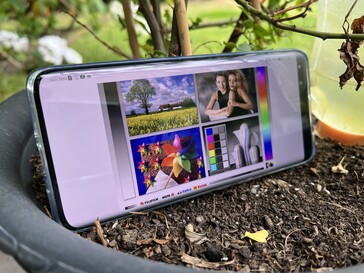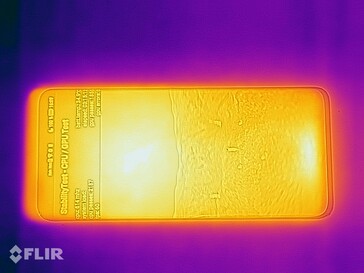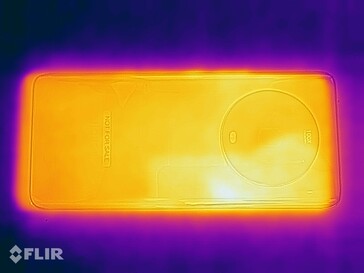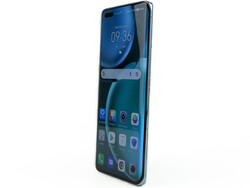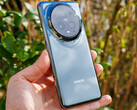Honor Magic4 Pro 5G review - Versatile camera smartphone with a wide range of features
Although the Honor Magic series was revived last year, our test device's predecessor Magic3 Pro did not come to Europe due to ongoing trade restrictions. Now that the former Huawei subsidiary has been sold to a Chinese investment syndicate, Honor no longer falls under the US sanctions and is thus able to source modern chipsets, 5G radios, and Google Mobile Services (GMS).
The Honor Magic4 Pro is not that different from its predecessor and uses the same design language. However, the display has slightly grown in size and both the SoC and the camera sensors have been upgraded. Conveniently, there is now an IP certification and high-power wired and wireless charging. Additionally, the Magic4 Pro is one of the few Android smartphones that make use of 3D facial recognition.
Potential Competitors in Comparison
Rating | Date | Model | Weight | Drive | Size | Resolution | Best Price |
|---|---|---|---|---|---|---|---|
| 88.6 % | 07/2022 | Honor Magic4 Pro SD 8 Gen 1, Adreno 730 | 215 g | 256 GB UFS 3.1 Flash | 6.81" | 2848x1312 | |
| 87.6 % | 02/2022 | Xiaomi 12 Pro SD 8 Gen 1, Adreno 730 | 204 g | 256 GB UFS 3.1 Flash | 6.73" | 3200x1440 | |
| 88.1 % | 06/2022 | OnePlus 10 Pro SD 8 Gen 1, Adreno 730 | 200.5 g | 256 GB UFS 3.1 Flash | 6.70" | 3216x1440 | |
| 89.4 % | 03/2022 | Samsung Galaxy S22 Ultra 5G Exynos 2200, Xclipse 920 | 228 g | 128 GB UFS 3.1 Flash | 6.80" | 3088x1440 | |
| 90.5 % | 10/2021 | Apple iPhone 13 Pro Max A15, A15 GPU 5-Core | 238 g | 128 GB NVMe | 6.70" | 2778x1284 | |
| 89.2 % | 04/2022 | Google Pixel 6 Pro Tensor, Mali-G78 MP20 | 210 g | 128 GB UFS 3.1 Flash | 6.70" | 3120x1440 | |
| 89.2 % | 04/2022 | Oppo Find X5 Pro SD 8 Gen 1, Adreno 730 | 221 g | 256 GB UFS 3.1 Flash | 6.70" | 3216x1440 |
Case - Lots of Glass and Similarities to the Mate Series
The Honor Magic4 Pro is available in black and cyan color variants with additional white, gold, and orange versions being potentially available depending on the region. Our test device is a cyan model with a thickness of 9.15 mm (~0.36 in) according to the datasheet. We measured 9.45 mm (~0.37 in). Due to the camera setup taking up a lot of space, the smartphone does not wiggle around when set down on a flat surface. With 1.7 mm (~0.07 in), the camera bump is not too pronounced.
We are very pleased with the workmanship. The slim metal frame makes for a robust and premium appearance. The glass display sits flush with the frame and the slightly sloped glass edges make the Honor look almost frameless, an impression that is further reinforced by the screen-to-body ratio of 93%. While the clearances are tight and even, the Magic4 Pro creaks noticeably when twisted from the corners.
There is a recessed SIM tray cover inside the frame with an identical color finish and a metal front. The tray itself consists of black plastic and accepts two nano SIM cards. The battery is fixed and not user replaceable. With an IP68 certification, the Honor Magic4 Pro is both water- and dustproof.
Connectivity - Honor Smartphone with USB 3.2 and IR Blaster
Although the USB 3.2 port (gen. 1) of the Honor Magic4 Pro is able to transfer data at up to 5 Gb/s, the package only includes a USB 2.0 cable. The interface supports both OTG as well as video output to HDMI and DisplayPort devices. Here, users are able to choose between simple screen mirroring or using the integrated desktop mode.
Expanding the storage is not possible. There is also no FM receiver or notification LED. If desired, the latter can be replaced by a feature of the always-on display, however. The connectivity of the Honor phone is otherwise excellent with modern Bluetooth 5.2, NFC, and an IR blaster that can be used to control multimedia devices, cameras, or air conditioners.
Software - Google Android 12 including Desktop Mode
Android 12 is the operating system of choice with the manufacturer's own Magic UI 6.0 layered on top. Users familiar with past Honor smartphones will feel right at home. Since the Google apps and services are no longer missing, both the Play Store and Google Pay are once again available.
There are only a few preinstalled third-party apps on the Magic4 Pro including Netflix and TikTok and they can be easily uninstalled. At the time of this article, the security patches date back to May 1st 2022, making them fairly recent. Honor promises two major Android version updates, so up to Android 14, and security patches for four years.
If the smartphone is connected to a monitor or TV via an optional cable, the integrated desktop mode can be used. Although it worked well during our testing, we were unable to access the Play Store or Chrome in this mode. Other browsers worked without any issues.
Communication and GNSS - Magic4 Pro with 5G and Wi-Fi 6
In terms of the communication, the Honor Magic4 Pro comes with a slight drawback, since the latest Wi-Fi 6E standard is not supported and 6-GHz can thus not be used. By contrast, the Honor does support VHT160, making the transfer speeds between it and our reference router Asus ROG Rapture GT-AXE11000 not just consistent, but extremely fast even in the 5-GHz network.
All major standards for cellular networks including 5G sub6 are available. Since the amount of supported frequencies is high, users should be able to access the web from most countries in the world.
| Networking | |
| Honor Magic4 Pro | |
| iperf3 receive AXE11000 |
|
| iperf3 transmit AXE11000 |
|
| Xiaomi 12 Pro | |
| iperf3 receive AXE11000 |
|
| iperf3 transmit AXE11000 |
|
| OnePlus 10 Pro | |
| iperf3 receive AXE11000 |
|
| iperf3 transmit AXE11000 |
|
| Samsung Galaxy S22 Ultra 5G | |
| iperf3 receive AXE11000 |
|
| iperf3 transmit AXE11000 |
|
| iperf3 transmit AXE11000 6GHz |
|
| iperf3 receive AXE11000 6GHz |
|
| Apple iPhone 13 Pro Max | |
| iperf3 transmit AX12 |
|
| iperf3 receive AX12 |
|
| Google Pixel 6 Pro | |
| iperf3 receive AXE11000 |
|
| iperf3 transmit AXE11000 |
|
| Oppo Find X5 Pro | |
| iperf3 receive AXE11000 |
|
| iperf3 transmit AXE11000 |
|
| Average of class Smartphone | |
| iperf3 receive AXE11000 |
|
| iperf3 transmit AXE11000 |
|
| iperf3 transmit AXE11000 6GHz |
|
| iperf3 receive AXE11000 6GHz |
|
| iperf3 receive AX12 |
|
For geolocation purposes, the Magic4 Pro has access to a wide range of satellite networks and even allows for triple connectivity. Outdoors, the satellite uplink is quickly established and even indoors, the smartphone is able to locate us within just a few seconds.
We put the Magic4 Pro up against the Garmin Venu 2 on our small test track for comparison purposes. The difference between the recorded distances amounts to only 20 meters (~65.6 ft) at a total distance of just under ten kilometers (~6.21 mi). A closer look at the detailed route attests to the Honor smartphone's precise geolocation capabilities.
Telephony and Call Quality
The Magic4 Pro supports common telephony features such as VoLTE, VoWi-Fi, and even an eSIM instead of a secondary, physical nano SIM card. However, the Honor operating system does not include SIP account management.
When held up to an ear, the call quality is very natural sounding and warrants no criticism; even minor ambient or static background noise is filtered out reliably. Unfortunately, this changes when using the speakerphone. Users then sound somewhat hollow and dull, although the volume level remains consistent and the range at which the microphone captures voices is also decent.
Cameras - Versatile Triple Camera with Slight Video Stuttering Issues
There is a 12-MP front camera and a 3D ToF on the front of the Honor Magic4Pro inside a cutout in the display. Under good lighting conditions, the pictures look fairly good, while the automatic HDR mode balances out shots against the light. Additionally, the smartphone comes with a Bokeh mode and a highly customizable beauty mode. Video recordings can be created at up to Ultra HD and 30 FPS.
The main sensor of the triple camera on the back is a 50-MP sensor. While Honor does not go into detail about its origin, the data sheet points towards a Sony IMX766 sensor. The pictures in daylight shine with good contrast and many details. Similarly, the Magic4 Pro's dynamic range makes for appealing shots. Although the colors are brightened a lot, they do not look oversaturated. We are very pleased with the overall image composition of the Honor smartphone. That being said, low-light situations result in noticeably muddy areas. Here, Honor may have been better off reducing the brightening in favor of capturing more details.
While the ultrawide sensor also has a resolution of 50 MP, it is smaller than the main sensor. Under daylight, it captures appealing pictures with a sufficient depth of field and no chromatic aberrations. The periscope optics offers a 3.5x optical zoom, and up to 100x digital zoom. Pictures remain acceptable up to about 10x zoom, with higher zoom levels giving up too much in terms of sharpness and details.
Video recording is also one of the main focuses of the Honor Magic4 Pro. The normal video mode supports up to Ultra HD resolution at up to 30 or 60 FPS at aspect ratios of 16:9 or 21:9. Switching to the film mode allows users to choose between 30 and 24 FPS (UHD), an optional HDR10+ mode, and the LOG mode (60 FPS). The LOG mode offers a particularly high bitrate (Rec.709 format, 10 Bit, IMAX Enhanced) and promises more post-processing flexibility. Although we are pleased with the visuals of the videos, panning still causes slight stuttering - we hope that Honor will fix this in a future update.
Image Comparison
Choose a scene and navigate within the first image. One click changes the position on touchscreens. One click on the zoomed-in image opens the original in a new window. The first image shows the scaled photograph of the test device.
Main cameraMain cameraUltra wide-angle5x ZoomLow-LightUnder controlled lighting conditions, the level of detail in the center of the test chart picture is not ideal. At least, the performance does not significantly degrade towards the edges.
ColorChecker shows that dark green and dark skin shades are overly brightened. Meanwhile, cyan is slightly oversaturated.
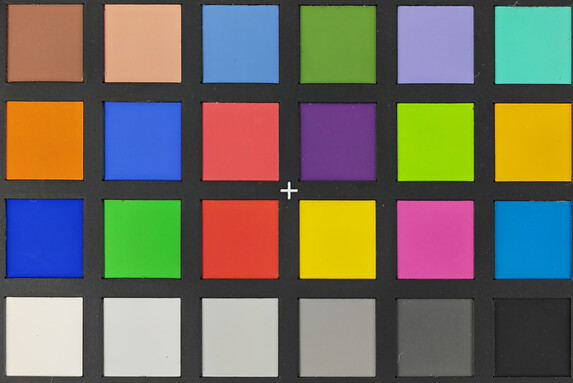
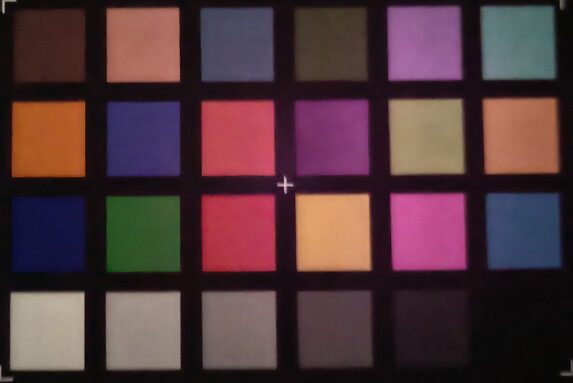
Accessories and Warranty - 100-Watt Charger included
The package of the Honor Magic4 Pro includes a powerful 100-watt charger, an appropriate USB cable (Type-A to Type-C), a SIM tool, and a transparent silicone case. A wireless 100W charging station for around 100 USD and a black PU case for about 20 USD are also available.
Honor offers an up to 2-year limited warranty depending on the place of purchase.
Input Devices & Handling - Magic4 Pro with Secure Biometrics
The Honor Magic4 Pro has a capacitive touchscreen that is able to simultaneously detect up to ten inputs. It comes with a factory-applied screen protector with good gliding properties. While the transition at the edges is somewhat rough, this can be easily remedied by using the included bumper.
The knuckle gestures from previous models are once again available and there are a few additional features such as Multi Window and Smart Sensing, which can be enabled from the settings. A one-handed mode can be enabled as well, although it may take some practice in conjunction with the gesture controls.
The biometric security features are high-tech. This is one of the few Android smartphones with 3D facial recognition (ToF). The authentication is not only fast but also more secure compared to the 2D counterpart via the front camera. Similarly, the under-display fingerprint sensor is an ultrasound model, which quickly and reliably unlocks the phone through a saved print. A total of five fingerprints can be saved.
Display - Honor Smartphone with Bright LTPO OLED and 120 Hz
The Honor Magic4 Pro comes with a 6.81-inch LTPO OLED panel that offers a high pixel density and a unique resolution that falls somewhere between Full HD and QHD+. The system is able to automatically adjust the refresh rate between 1 and 120 Hz or users can select a fixed 60-, 90-, or 120-Hz refresh rate. HLG, HDR10, and HDR10+ are supported for displaying HDR content.
The brightness of a purely white image reaches 956 nits with the ambient light sensor enabled. The OLED panel produces similar results in the APL measurements. When controlling the brightness manually, up to 573 nits is possible. Unfortunately, the minimum luminance is somewhat high.
While the Magic4 Pro suffers from screen flickering like all other OLEDs, Honor promises a DC dimming mode with a frequency of 1920 Hz for noticeably reduced eyestrain. In our measurements, this manifests as a steady cycle with a consistent frequency that matches the refresh rate.
| |||||||||||||||||||||||||
Brightness Distribution: 94 %
Center on Battery: 956 cd/m²
Contrast: ∞:1 (Black: 0 cd/m²)
ΔE Color 2.4 | 0.5-29.43 Ø5
ΔE Greyscale 3.3 | 0.57-98 Ø5.3
94.7% sRGB (Calman 2D)
Gamma: 2.26
| Honor Magic4 Pro OLED, 2848x1312, 6.81 | Xiaomi 12 Pro AMOLED, 3200x1440, 6.73 | OnePlus 10 Pro AMOLED, 3216x1440, 6.70 | Samsung Galaxy S22 Ultra 5G Dynamic AMOLED, 3088x1440, 6.80 | Apple iPhone 13 Pro Max OLED, 2778x1284, 6.70 | Google Pixel 6 Pro LTPO-OLED, 3120x1440, 6.70 | Oppo Find X5 Pro AMOLED, 3216x1440, 6.70 | |
|---|---|---|---|---|---|---|---|
| Screen | 23% | 26% | 34% | 39% | 24% | 24% | |
| Brightness middle | 956 | 959 0% | 793 -17% | 1077 13% | 1049 10% | 794 -17% | 746 -22% |
| Brightness | 959 | 977 2% | 776 -19% | 1093 14% | 1060 11% | 801 -16% | 744 -22% |
| Brightness Distribution | 94 | 96 2% | 95 1% | 97 3% | 98 4% | 97 3% | 97 3% |
| Black Level * | |||||||
| Colorchecker dE 2000 * | 2.4 | 1.1 54% | 0.79 67% | 1.2 50% | 0.78 67% | 0.9 62% | 0.9 62% |
| Colorchecker dE 2000 max. * | 5.2 | 3.1 40% | 1.93 63% | 2 62% | 1.72 67% | 2.2 58% | 1.6 69% |
| Greyscale dE 2000 * | 3.3 | 1.9 42% | 1.3 61% | 1.3 61% | 0.8 76% | 1.5 55% | 1.6 52% |
| Gamma | 2.26 97% | 2.22 99% | 2.223 99% | 2.37 93% | 2.181 101% | 2.23 99% | 2.23 99% |
| CCT | 6804 96% | 6498 100% | 6624 98% | 6526 100% | 6559 99% | 6654 98% | 6499 100% |
* ... smaller is better
Screen Flickering / PWM (Pulse-Width Modulation)
| Screen flickering / PWM detected | 119.9 Hz | ||
The display backlight flickers at 119.9 Hz (worst case, e.g., utilizing PWM) . The frequency of 119.9 Hz is very low, so the flickering may cause eyestrain and headaches after extended use. In comparison: 53 % of all tested devices do not use PWM to dim the display. If PWM was detected, an average of 17900 (minimum: 5 - maximum: 3846000) Hz was measured. | |||
Measurements at a fixed zoom level and various brightness settings
While the panel of the Honor Magic4 Pro can produce good images, this required us to adjust the settings and limit it to the smaller sRGB color space. Curiously, we had to choose the color temperature setting Cold. The color balance is warmer on the default settings and suffers from a green tint, which makes the screen content look somewhat sickly.
Although the Honor smartphone does well, it is not quite as color accurate as competitors from the same price category.
Display Response Times
| ↔ Response Time Black to White | ||
|---|---|---|
| 1.49 ms ... rise ↗ and fall ↘ combined | ↗ 0.629 ms rise | |
| ↘ 0.559 ms fall | ||
| The screen shows very fast response rates in our tests and should be very well suited for fast-paced gaming. In comparison, all tested devices range from 0.1 (minimum) to 240 (maximum) ms. » 4 % of all devices are better. This means that the measured response time is better than the average of all tested devices (21.5 ms). | ||
| ↔ Response Time 50% Grey to 80% Grey | ||
| 1.01 ms ... rise ↗ and fall ↘ combined | ↗ 0.484 ms rise | |
| ↘ 0.523 ms fall | ||
| The screen shows very fast response rates in our tests and should be very well suited for fast-paced gaming. In comparison, all tested devices range from 0.2 (minimum) to 636 (maximum) ms. » 2 % of all devices are better. This means that the measured response time is better than the average of all tested devices (33.7 ms). | ||
Performance - Magic4 Pro with Snapdragon 8 Gen 1
The Honor Magic4 Pro relies on a powerful Qualcomm Snapdragon 8 Gen 1, which - after the brand-new Snapdragon 8+ gen 1 - is the fastest Android SoC currently available. Additionally, the Honor phone receives 8 GB of LPDDR5 RAM with a 12-GB variant being available at certain retailers.
The Magic smartphone comes with a so-called performance mode, which has little to no effect on the CPU and system performance. The Geekbench results remained at the same level, while the AI and system performance rose by a few percentage points. For day-to-day tasks, the accompanying increased power draw is not a worthwhile trade. However, the benchmarks fall somewhat short of our expectations with the performance mode disabled. Although the Geekbench single-core performance remains identical, the all-core performance drops by around 10 %.
| UL Procyon AI Inference for Android - Overall Score NNAPI | |
| Honor Magic4 Pro | |
| Average Qualcomm Snapdragon 8 Gen 1 (61568 - 81722, n=8) | |
| Oppo Find X5 Pro | |
| Xiaomi 12 Pro | |
| Google Pixel 6 Pro | |
| Average of class Smartphone (207 - 84787, n=150, last 2 years) | |
| Samsung Galaxy S22 Ultra 5G | |
The Magic4 Pro's Adreno 730 offers lots of graphics performance and the benchmark results mostly match our expectations for this graphics chip. However, as the offscreen results of GFXBench show, there is often untapped potential, indicating that the SoC's cooling solution is not equipped to support a consistently high-performance level.
GFXBench (DX / GLBenchmark) 2.7: T-Rex Onscreen | 1920x1080 T-Rex Offscreen
GFXBench 3.0: on screen Manhattan Onscreen OGL | 1920x1080 1080p Manhattan Offscreen
GFXBench 3.1: on screen Manhattan ES 3.1 Onscreen | 1920x1080 Manhattan ES 3.1 Offscreen
GFXBench: on screen Car Chase Onscreen | 1920x1080 Car Chase Offscreen | on screen Aztec Ruins High Tier Onscreen | 2560x1440 Aztec Ruins High Tier Offscreen | on screen Aztec Ruins Normal Tier Onscreen | 1920x1080 Aztec Ruins Normal Tier Offscreen
| 3DMark / Wild Life Extreme Unlimited | |
| Apple iPhone 13 Pro Max | |
| Honor Magic4 Pro | |
| OnePlus 10 Pro | |
| Oppo Find X5 Pro | |
| Xiaomi 12 Pro | |
| Google Pixel 6 Pro | |
| Samsung Galaxy S22 Ultra 5G | |
| 3DMark / Wild Life Extreme | |
| Apple iPhone 13 Pro Max | |
| Honor Magic4 Pro | |
| OnePlus 10 Pro | |
| Xiaomi 12 Pro | |
| Oppo Find X5 Pro | |
| Samsung Galaxy S22 Ultra 5G | |
| Google Pixel 6 Pro | |
| 3DMark / Wild Life Unlimited Score | |
| Apple iPhone 13 Pro Max | |
| Xiaomi 12 Pro | |
| Honor Magic4 Pro | |
| OnePlus 10 Pro | |
| Oppo Find X5 Pro | |
| Samsung Galaxy S22 Ultra 5G | |
| Google Pixel 6 Pro | |
| 3DMark / Wild Life Score | |
| OnePlus 10 Pro | |
| Xiaomi 12 Pro | |
| Oppo Find X5 Pro | |
| Apple iPhone 13 Pro Max | |
| Samsung Galaxy S22 Ultra 5G | |
| Google Pixel 6 Pro | |
| Honor Magic4 Pro | |
| 3DMark / Sling Shot Extreme (ES 3.1) Unlimited Physics | |
| Xiaomi 12 Pro | |
| OnePlus 10 Pro | |
| Samsung Galaxy S22 Ultra 5G | |
| Google Pixel 6 Pro | |
| Oppo Find X5 Pro | |
| Honor Magic4 Pro | |
| Apple iPhone 13 Pro Max | |
| 3DMark / Sling Shot Extreme (ES 3.1) Unlimited Graphics | |
| OnePlus 10 Pro | |
| Honor Magic4 Pro | |
| Oppo Find X5 Pro | |
| Apple iPhone 13 Pro Max | |
| Xiaomi 12 Pro | |
| Samsung Galaxy S22 Ultra 5G | |
| Google Pixel 6 Pro | |
| 3DMark / Sling Shot Extreme (ES 3.1) Unlimited | |
| OnePlus 10 Pro | |
| Oppo Find X5 Pro | |
| Honor Magic4 Pro | |
| Xiaomi 12 Pro | |
| Samsung Galaxy S22 Ultra 5G | |
| Google Pixel 6 Pro | |
| Apple iPhone 13 Pro Max | |
| 3DMark / Sling Shot OpenGL ES 3.0 Unlimited | |
| Oppo Find X5 Pro | |
| Honor Magic4 Pro | |
| OnePlus 10 Pro | |
| Xiaomi 12 Pro | |
| Samsung Galaxy S22 Ultra 5G | |
| Google Pixel 6 Pro | |
| 3DMark / Sling Shot OpenGL ES 3.0 Unlimited Graphics | |
| Honor Magic4 Pro | |
| Oppo Find X5 Pro | |
| OnePlus 10 Pro | |
| Xiaomi 12 Pro | |
| Samsung Galaxy S22 Ultra 5G | |
| Google Pixel 6 Pro | |
| 3DMark / Sling Shot OpenGL ES 3.0 Unlimited Physics | |
| Oppo Find X5 Pro | |
| Google Pixel 6 Pro | |
| Xiaomi 12 Pro | |
| Samsung Galaxy S22 Ultra 5G | |
| Honor Magic4 Pro | |
| OnePlus 10 Pro | |
| GFXBench (DX / GLBenchmark) 2.7 / T-Rex Onscreen | |
| Xiaomi 12 Pro | |
| Honor Magic4 Pro | |
| Samsung Galaxy S22 Ultra 5G | |
| Google Pixel 6 Pro | |
| Apple iPhone 13 Pro Max | |
| OnePlus 10 Pro | |
| Oppo Find X5 Pro | |
| GFXBench (DX / GLBenchmark) 2.7 / T-Rex Offscreen | |
| Honor Magic4 Pro | |
| Xiaomi 12 Pro | |
| Apple iPhone 13 Pro Max | |
| Oppo Find X5 Pro | |
| OnePlus 10 Pro | |
| Samsung Galaxy S22 Ultra 5G | |
| Google Pixel 6 Pro | |
| GFXBench 3.0 / Manhattan Onscreen OGL | |
| Xiaomi 12 Pro | |
| Honor Magic4 Pro | |
| Samsung Galaxy S22 Ultra 5G | |
| Google Pixel 6 Pro | |
| Apple iPhone 13 Pro Max | |
| OnePlus 10 Pro | |
| Oppo Find X5 Pro | |
| GFXBench 3.0 / 1080p Manhattan Offscreen | |
| Xiaomi 12 Pro | |
| Apple iPhone 13 Pro Max | |
| OnePlus 10 Pro | |
| Samsung Galaxy S22 Ultra 5G | |
| Honor Magic4 Pro | |
| Oppo Find X5 Pro | |
| Google Pixel 6 Pro | |
| GFXBench 3.1 / Manhattan ES 3.1 Onscreen | |
| Honor Magic4 Pro | |
| Xiaomi 12 Pro | |
| Samsung Galaxy S22 Ultra 5G | |
| Apple iPhone 13 Pro Max | |
| OnePlus 10 Pro | |
| Oppo Find X5 Pro | |
| Google Pixel 6 Pro | |
| GFXBench 3.1 / Manhattan ES 3.1 Offscreen | |
| Xiaomi 12 Pro | |
| Honor Magic4 Pro | |
| Apple iPhone 13 Pro Max | |
| OnePlus 10 Pro | |
| Samsung Galaxy S22 Ultra 5G | |
| Oppo Find X5 Pro | |
| Google Pixel 6 Pro | |
| GFXBench / Car Chase Onscreen | |
| OnePlus 10 Pro | |
| Honor Magic4 Pro | |
| Apple iPhone 13 Pro Max | |
| Samsung Galaxy S22 Ultra 5G | |
| Oppo Find X5 Pro | |
| Xiaomi 12 Pro | |
| Google Pixel 6 Pro | |
| GFXBench / Car Chase Offscreen | |
| Honor Magic4 Pro | |
| Apple iPhone 13 Pro Max | |
| Xiaomi 12 Pro | |
| OnePlus 10 Pro | |
| Samsung Galaxy S22 Ultra 5G | |
| Oppo Find X5 Pro | |
| Google Pixel 6 Pro | |
| GFXBench / Aztec Ruins High Tier Onscreen | |
| OnePlus 10 Pro | |
| Apple iPhone 13 Pro Max | |
| Honor Magic4 Pro | |
| Oppo Find X5 Pro | |
| Google Pixel 6 Pro | |
| Samsung Galaxy S22 Ultra 5G | |
| Xiaomi 12 Pro | |
| GFXBench / Aztec Ruins High Tier Offscreen | |
| Honor Magic4 Pro | |
| OnePlus 10 Pro | |
| Oppo Find X5 Pro | |
| Apple iPhone 13 Pro Max | |
| Xiaomi 12 Pro | |
| Google Pixel 6 Pro | |
| Samsung Galaxy S22 Ultra 5G | |
| GFXBench / Aztec Ruins Normal Tier Onscreen | |
| Honor Magic4 Pro | |
| OnePlus 10 Pro | |
| Apple iPhone 13 Pro Max | |
| Oppo Find X5 Pro | |
| Xiaomi 12 Pro | |
| Google Pixel 6 Pro | |
| Samsung Galaxy S22 Ultra 5G | |
| GFXBench / Aztec Ruins Normal Tier Offscreen | |
| Honor Magic4 Pro | |
| Apple iPhone 13 Pro Max | |
| OnePlus 10 Pro | |
| Oppo Find X5 Pro | |
| Xiaomi 12 Pro | |
| Google Pixel 6 Pro | |
| Samsung Galaxy S22 Ultra 5G | |
While the web browsing performance is the lowest compared to the other devices in our comparison, the subjective experience is still good.
| Jetstream 2 - Total Score | |
| Apple iPhone 13 Pro Max (Safari 15) | |
| Average Qualcomm Snapdragon 8 Gen 1 (72.8 - 134.6, n=16) | |
| Average of class Smartphone (13.8 - 351, n=173, last 2 years) | |
| Oppo Find X5 Pro (Chrome 99) | |
| OnePlus 10 Pro (Chrome100) | |
| Samsung Galaxy S22 Ultra 5G (Chrome 99) | |
| Google Pixel 6 Pro (Chrome 100) | |
| Xiaomi 12 Pro (Chrome 97) | |
| Honor Magic4 Pro (Chrome 102) | |
| Speedometer 2.0 - Result | |
| Apple iPhone 13 Pro Max (Safari 15) | |
| OnePlus 10 Pro (Chrome100) | |
| Google Pixel 6 Pro (Chrome 100) | |
| Samsung Galaxy S22 Ultra 5G (Chrome 99) | |
| Average of class Smartphone (14.9 - 445, n=157, last 2 years) | |
| Oppo Find X5 Pro (Chrome 99) | |
| Average Qualcomm Snapdragon 8 Gen 1 (64.4 - 129.3, n=16) | |
| Xiaomi 12 Pro (Chrome 97) | |
| Honor Magic4 Pro (Chrome 102) | |
| WebXPRT 3 - Overall | |
| Apple iPhone 13 Pro Max (Safari 15) | |
| OnePlus 10 Pro (Chrome100) | |
| Average Qualcomm Snapdragon 8 Gen 1 (79 - 193, n=15) | |
| Average of class Smartphone (39 - 304, n=122, last 2 years) | |
| Oppo Find X5 Pro (Chrome 99) | |
| Samsung Galaxy S22 Ultra 5G (Chrome 99) | |
| Xiaomi 12 Pro (Chrome 97) | |
| Google Pixel 6 Pro (Chrome 100) | |
| Honor Magic4 Pro (Chrome 102) | |
| Octane V2 - Total Score | |
| Apple iPhone 13 Pro Max (Safari 15) | |
| OnePlus 10 Pro (Chrome100) | |
| Google Pixel 6 Pro (Chrome 100) | |
| Average Qualcomm Snapdragon 8 Gen 1 (27730 - 50626, n=17) | |
| Oppo Find X5 Pro (Chrome 99) | |
| Samsung Galaxy S22 Ultra 5G (Chrome 99) | |
| Average of class Smartphone (4633 - 89112, n=211, last 2 years) | |
| Xiaomi 12 Pro (Chrome 97) | |
| Honor Magic4 Pro (Chrome 102) | |
| Mozilla Kraken 1.1 - Total | |
| Average of class Smartphone (388 - 9999, n=173, last 2 years) | |
| Honor Magic4 Pro (Chrome 102) | |
| Xiaomi 12 Pro (Chrome 97) | |
| Samsung Galaxy S22 Ultra 5G (Chrome 99) | |
| Oppo Find X5 Pro (Chrome 99) | |
| Average Qualcomm Snapdragon 8 Gen 1 (814 - 1440, n=16) | |
| Google Pixel 6 Pro (Chrome 100) | |
| OnePlus 10 Pro (Chrome100) | |
| Apple iPhone 13 Pro Max (Safari 15) | |
| WebXPRT 4 - Overall | |
| Average of class Smartphone (22 - 202, n=160, last 2 years) | |
| Average Qualcomm Snapdragon 8 Gen 1 (68 - 119, n=4) | |
| Honor Magic4 Pro (Chrome 102) | |
* ... smaller is better
With 8GB of RAM and 256 GB of internal UFS 3.1 storage, the Magic4 Pro's memory configuration is decent. In light of the price, however, at least the RAM capacity could have been higher. In China, there are two more memory configurations: 12/256 GB and 12/512 GB.
We have no complaints regarding the speeds of the installed memory, which allows for fast data transfers.
| Honor Magic4 Pro | Xiaomi 12 Pro | OnePlus 10 Pro | Samsung Galaxy S22 Ultra 5G | Google Pixel 6 Pro | Oppo Find X5 Pro | Average 256 GB UFS 3.1 Flash | Average of class Smartphone | |
|---|---|---|---|---|---|---|---|---|
| AndroBench 3-5 | 10% | -11% | -10% | -51% | -34% | -8% | -18% | |
| Sequential Read 256KB | 1868.5 | 1620 -13% | 1602.12 -14% | 1653 -12% | 1560 -17% | 1410 -25% | 1760 ? -6% | 1505 ? -19% |
| Sequential Write 256KB | 1367.48 | 1465 7% | 1253.34 -8% | 1074 -21% | 242.5 -82% | 894 -35% | 1134 ? -17% | 1112 ? -19% |
| Random Read 4KB | 268.76 | 324.9 21% | 284.34 6% | 322.3 20% | 129.4 -52% | 183.7 -32% | 281 ? 5% | 247 ? -8% |
| Random Write 4KB | 366.13 | 448.9 23% | 264.45 -28% | 273.1 -25% | 178.5 -51% | 210.4 -43% | 311 ? -15% | 271 ? -26% |
Gaming - Honor Smartphone with Lots of Gaming Power
While we would have liked to show our GameBench gaming benchmarks here, the frame rates are not being logged, even though Gamebench appears to begin recording the FPS. We were unable to determine the cause and contacted GameBench regarding the issue to hopefully be able to append the results in the future.
The Adreno 730 offers fast gaming performance and runs all titles smoothly at maximum details. PUBG Mobile allows the selection of the Ultra HD setting and does not suffer from stuttering. Less demanding titles such as Armajet allow for an uncapped frame rate. Thus, 120 FPS is theoretically possible, but unlikely based on our experience. However, similar frame rates are definitely achievable in other HFR games.
Emissions - Decent Stereo Speakers
Temperature
The surface temperatures of the Honor Magic4 Pro 5G remain low in all scenarios for comfortable handling.
The opposite holds true for the SoC temperature. Here, the Honor smartphone throttles fairly early, but still manages to land in the same range as its Snapdragon 8 gen 1 competitors in terms of long-term performance, whereas the Xiaomi 12 Pro is the only outlier due to heavier throttling.
(+) The maximum temperature on the upper side is 34.7 °C / 94 F, compared to the average of 35 °C / 95 F, ranging from 21.9 to 56 °C for the class Smartphone.
(+) The bottom heats up to a maximum of 33.2 °C / 92 F, compared to the average of 33.8 °C / 93 F
(+) In idle usage, the average temperature for the upper side is 29.7 °C / 85 F, compared to the device average of 32.7 °C / 91 F.
3DMark Wild Life Stress Test
| 3DMark | |
| Wild Life Stress Test Stability | |
| Apple iPhone 13 Pro Max | |
| OnePlus 10 Pro | |
| Honor Magic4 Pro | |
| Oppo Find X5 Pro | |
| Samsung Galaxy S22 Ultra 5G | |
| Xiaomi 12 Pro | |
| Google Pixel 6 Pro | |
| Wild Life Extreme Stress Test | |
| Apple iPhone 13 Pro Max | |
| OnePlus 10 Pro | |
| Oppo Find X5 Pro | |
| Honor Magic4 Pro | |
| Samsung Galaxy S22 Ultra 5G | |
| Google Pixel 6 Pro | |
| Xiaomi 12 Pro | |
Speakers
The two speakers of the Honor Magic4 Pro offer a fairly decent sound that, while it lacks bass, is fairly pleasant to listen to, particularly at medium volume levels. At higher volume levels, the treble becomes somewhat overwhelming for a somewhat hollow overall sound.
Since there is no headphone jack, wired headphones and headsets can only be connected via USB. Of course, it is also possible to use an adapter instead. The Magic4 Pro is well-prepared for wireless audio and supports all major audio codecs (SBC, AAC, aptX, aptX HD, and LDAC).
Honor Magic4 Pro audio analysis
(+) | speakers can play relatively loud (88.5 dB)
Bass 100 - 315 Hz
(-) | nearly no bass - on average 27.6% lower than median
(±) | linearity of bass is average (9.5% delta to prev. frequency)
Mids 400 - 2000 Hz
(±) | reduced mids - on average 7.2% lower than median
(+) | mids are linear (5.5% delta to prev. frequency)
Highs 2 - 16 kHz
(±) | higher highs - on average 5.8% higher than median
(+) | highs are linear (2.9% delta to prev. frequency)
Overall 100 - 16.000 Hz
(±) | linearity of overall sound is average (20.1% difference to median)
Compared to same class
» 26% of all tested devices in this class were better, 9% similar, 65% worse
» The best had a delta of 12%, average was 38%, worst was 134%
Compared to all devices tested
» 46% of all tested devices were better, 8% similar, 45% worse
» The best had a delta of 4%, average was 25%, worst was 134%
Samsung Galaxy S22 Ultra 5G audio analysis
(+) | speakers can play relatively loud (90.2 dB)
Bass 100 - 315 Hz
(-) | nearly no bass - on average 24.4% lower than median
(±) | linearity of bass is average (8.8% delta to prev. frequency)
Mids 400 - 2000 Hz
(±) | higher mids - on average 6.3% higher than median
(+) | mids are linear (4.8% delta to prev. frequency)
Highs 2 - 16 kHz
(±) | higher highs - on average 5.6% higher than median
(+) | highs are linear (4.1% delta to prev. frequency)
Overall 100 - 16.000 Hz
(±) | linearity of overall sound is average (18.5% difference to median)
Compared to same class
» 14% of all tested devices in this class were better, 9% similar, 77% worse
» The best had a delta of 12%, average was 38%, worst was 134%
Compared to all devices tested
» 36% of all tested devices were better, 8% similar, 56% worse
» The best had a delta of 4%, average was 25%, worst was 134%
Battery Life - Fast Charging at up to 100 Watts
Energy Consumption
The power consumption of the Magic4 Pro at maximum brightness is slightly too high during idle. With an LTPO panel, the smartphone should be significantly more energy efficient. Similarly, the Honor phone draws a lot of power during our GFXBench test at a lower brightness setting.
With the included 100-watt SuperCharge charger, the Magic4 Pro can be fully recharged within 20 minutes. Wireless charging at up to 100 watts is also supported. Furthermore, other Qi-capable devices can be charged by the Magic4 Pro via reverse charging.
| Off / Standby | |
| Idle | |
| Load |
|
| Honor Magic4 Pro 4600 mAh | Xiaomi 12 Pro 4600 mAh | OnePlus 10 Pro 5000 mAh | Samsung Galaxy S22 Ultra 5G 5000 mAh | Apple iPhone 13 Pro Max 4352 mAh | Google Pixel 6 Pro 5003 mAh | Oppo Find X5 Pro 5000 mAh | Average Qualcomm Snapdragon 8 Gen 1 | Average of class Smartphone | |
|---|---|---|---|---|---|---|---|---|---|
| Power Consumption | 10% | 2% | 11% | 30% | 11% | 12% | -14% | 6% | |
| Idle Minimum * | 0.87 | 0.94 -8% | 0.7 20% | 0.58 33% | 0.6 31% | 0.7 20% | 1.24 -43% | 1.255 ? -44% | 0.897 ? -3% |
| Idle Average * | 2.04 | 1.24 39% | 1.1 46% | 0.71 65% | 1.5 26% | 1 51% | 1.39 32% | 2.02 ? 1% | 1.452 ? 29% |
| Idle Maximum * | 2.26 | 1.34 41% | 1.7 25% | 1.16 49% | 1.6 29% | 1.04 54% | 1.42 37% | 2.21 ? 2% | 1.629 ? 28% |
| Load Average * | 4.97 | 5.7 -15% | 6.4 -29% | 7.07 -42% | 3.5 30% | 6.87 -38% | 3.58 28% | 5.49 ? -10% | 5.55 ? -12% |
| Load Maximum * | 7.46 | 8.12 -9% | 11.3 -51% | 11.32 -52% | 4.8 36% | 9.87 -32% | 6.99 6% | 8.75 ? -17% | 8.31 ? -11% |
* ... smaller is better
Power Consumption: Geekbench (150 nits)
Power Consumption: GFXBench (150 nits)
Battery Life
The Honor Magic4 Pro uses a 4600-mAh battery, resulting in quite long overall runtimes. However, our real-world Wi-Fi test (150 nits) appears to be particularly taxing for the smartphone, which does not last as long as most competitors in this scenario and instead falls within the same range as the Pixel 6 Pro. That being said, the battery life is still good and more than sufficient for a full day.
| Honor Magic4 Pro 4600 mAh | Xiaomi 12 Pro 4600 mAh | OnePlus 10 Pro 5000 mAh | Samsung Galaxy S22 Ultra 5G 5000 mAh | Apple iPhone 13 Pro Max 4352 mAh | Google Pixel 6 Pro 5003 mAh | Oppo Find X5 Pro 5000 mAh | |
|---|---|---|---|---|---|---|---|
| Battery Runtime | 7% | 3% | 21% | 59% | -3% | 5% | |
| Reader / Idle | 1346 | 2036 51% | 1617 20% | 1973 47% | 2846 111% | 1269 -6% | |
| H.264 | 995 | 788 -21% | 1121 13% | 1078 8% | 1522 53% | 1142 15% | |
| WiFi v1.3 | 687 | 766 11% | 767 12% | 844 23% | 1067 55% | 667 -3% | 788 15% |
| Load | 389 | 337 -13% | 255 -34% | 410 5% | 452 16% | 367 -6% |
Pros
Cons
Verdict - Honor with a Strong Comeback
With the Magic4 Pro, Honor tries to revisit the not-too-distant glory days by presenting us with a well-equipped high-end smartphone, which does not need to hide from its competitors.
The main focus lies with the camera setup, which produces good results in our testing and also appears to have made up a lot of ground in terms of the video capturing capabilities. That being said, recording videos still is not an entirely smooth experience at the time of this article. However, we are confident that the video stuttering issue will be fixed in the next update.
The Honor Magic4 Pro is a high-end smartphone with good features and able to shine with a good camera, an IP68 certification, blazing-fast charging, and an appealing design.
With its bright LTPO display, fast Wi-Fi, IP68 certification, fast wired and wireless charging, USB 3.2 with desktop mode, and fast processor, the Honor device barely leaves anything to be desired. There are small drawbacks in terms of the Wi-Fi connectivity, which does not include 6 GHz frequencies. Furthermore, the display's peak brightness could have been slightly higher still.
If you are in need of a display with a greater luminance, the Galaxy S22 Ultra may be worth looking at, since it also comes with a longer guaranteed update period. The Pixel 6 Pro is another potential alternative with a good camera and a low price.
Price and Availability
For non-US based customers, the Honor Magic4 Pro is available for around 1100 Euros (MSRP) on Honor's own shop and often comes with bonus offerings such as cases, smartwatches, or charging stations. Alternatively, the smartphone can be found on non-US online retailers such as Amazon.co.uk and import shops such as Tradingshenzhen for about 800 pounds and 975 USD, respectively.
Honor Magic4 Pro
-
08/30/2022 v7
Daniel Schmidt


 Deutsch
Deutsch English
English Español
Español Français
Français Italiano
Italiano Nederlands
Nederlands Polski
Polski Português
Português Русский
Русский Türkçe
Türkçe Svenska
Svenska Chinese
Chinese Magyar
Magyar